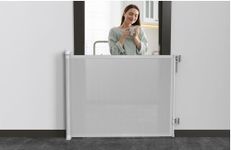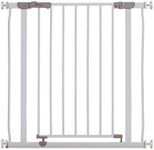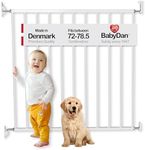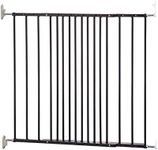Buying Guide for the Best Baby Gate No Drill
Choosing the right baby gate is crucial for ensuring the safety of your child while also maintaining the integrity of your home. A no-drill baby gate is an excellent option for those who want to avoid damaging walls or door frames. When selecting a baby gate, consider the specific areas you need to block off, the size and mobility of your child, and the ease of use for adults. It's important to find a balance between security, convenience, and aesthetics to ensure the gate fits seamlessly into your home environment.Type of MountingNo-drill baby gates typically use pressure mounting, which means they are held in place by tension rather than screws. This is important because it allows for easy installation and removal without causing damage to walls or door frames. Pressure-mounted gates are ideal for areas where you need a temporary solution or where drilling is not an option. However, they may not be as secure as hardware-mounted gates, so they are best used at the bottom of stairs or in doorways rather than at the top of stairs.
Width and HeightThe width and height of a baby gate are crucial for ensuring it fits the intended space and provides adequate security. Measure the width of the area where you plan to install the gate to ensure a proper fit. Most gates are adjustable to accommodate various widths, but it's important to check the specifications. The height of the gate should be tall enough to prevent your child from climbing over it. Generally, a gate that is at least 30 inches tall is recommended for toddlers.
MaterialBaby gates come in a variety of materials, including metal, wood, and plastic. The material affects the gate's durability, weight, and appearance. Metal gates are typically the most durable and secure, making them a good choice for high-traffic areas. Wooden gates can offer a more aesthetically pleasing look that blends with home decor, while plastic gates are lightweight and easy to move. Consider where the gate will be used and how it will fit with your home's style when choosing the material.
Ease of UseEase of use is an important factor, especially if you will be frequently opening and closing the gate. Look for gates with a simple locking mechanism that can be operated with one hand, as this will be more convenient when carrying your child or other items. Some gates have a walk-through door that swings open, which can be more convenient than having to step over the gate. Consider who will be using the gate and how often when evaluating ease of use.
Safety FeaturesSafety features are paramount when selecting a baby gate. Look for gates that meet safety standards and have features such as a secure locking mechanism and a sturdy frame. Some gates have additional safety features like a pressure indicator to ensure the gate is properly installed. It's also important to ensure that the gate does not have any sharp edges or small parts that could pose a hazard to your child. Consider the specific safety needs of your home and child when evaluating these features.














